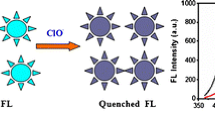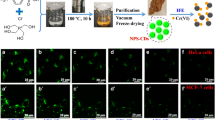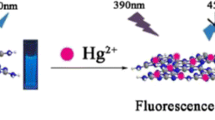Abstract
Carbon nanodots doped with boron and nitrogen (BN-CDs) with an average diameter of around 11 nm were prepared by a hydrothermal approach using adenine and 3-aminobenzene boronic acid as the starting materials. The atomic ratio of boron to nitrogen atomic in the BN-CDs is approximately 1:1. This indicates that a large fraction of N atoms goes lost during preparation because the B/N ratio of the precursors is about 1:6. The BN-CDs display blue fluorescence (best measured at excitation/emission wavelengths of 305/380 nm) which is independent of the excitation wavelength. On exposure to hypochlorite anion, fluorescence is quenched and the color of the solutions changes from yellow to brown. Fluorescence drops linearly in the 0.1–1000 μM hypochlorite concentration range. The colorimetric response, best measured as the absorbance ratio at 236/260 nm, ranges from 0.3 to 4.0 mM. The color changes can be readily detected visually. The probe was applied to the determination of hypochlorite in living cells and in (spiked) tap water.

Excitation wavelength-independent fluorescent boron and nitrogen codoped carbon nanodots (BN-CDs) were obtained by a hydrothermal approach. The BN-CDs were used to detect hypochlorite in wastewater by a fluorometric and colorimetric dual-readout assay.






Similar content being viewed by others
References
Aoki T, Munemori M (1983) Continuous flow determination of free chlorine in water. Anal Chem 55:209–212
Lin W, Long L, Chen B, Tan W (2009) A ratiometric fluorescent probe for hypochlorite based on a deoximation reaction. Chem Eur J 15:2305–2309
Lin Y, Yao B, Huang T, Zhang S, Cao X, Weng W (2016) Selective determination of free dissolved chlorine using nitrogen-doped carbon dots as a fluorescent probe. Microchim Acta 183:2221–2227
Tang Q, Yang T, Huang Y (2015) Copper nanocluster-based fluorescent probe for hypochlorite. Microchim Acta 182:2337–2343
Yin C, Zhen X, Fan Q, Huang W, Pu K (2017) Degradable semiconducting oligomer amphiphile for ratiometric photoacoustic imaging of hypochlorite. ACS Nano 11:4174–4182
Zhang P, Wang Y, Chen L, Yin Y (2017) Bimetallic nanoclusters with strong red fluorescence for sensitive detection of hypochlorite in tap water. Microchim Acta 184:3781–3787
Li J, Yin C, Huo F, Xiong K, Chao J, Zhang Y (2016) Two high selective and sensitive ratiometric fluorescence probes for detecting hypochlorite. Sensors Actuators B Chem 231:547–551
Xue L, Feng Y, Song Y, Wang R, Liu D, Du J, Yang Q, Li Y (2018) A highly selective and sensitive ratiometric fluorescent probe for hypochlorite and its application. Chem Res Chinese U 34:536–540
Yan Y, Wang S, Liu Z, Wang H, Huang D (2010) CdSe-ZnS quantum dots for selective and sensitive detection and quantification of hypochlorite. Anal Chem 82:9775–9781
Jiang Y, Zheng G, Duan Q, Yang L, Zhang J, Zhang H, He J, Sun H, Ho D (2018) Ultra-sensitive fluorescent probes for hypochlorite acid detection and exogenous/endogenous imaging of living cells. Chem Commun 54:7967–7970
Wang ZX, Kong FY, Wang W (2017) Near-ultraviolet fluorescent “ON-OFF-ON” switching sensors based on nitrogen-enriched dual-color single-functional polymer carbon nanosheets. Chem Eur J 23:665–675
Cao L, Meziani MJ, Sahu S, Sun YP (2013) Photoluminescence properties of graphene versus other carbon nanomaterials. Acc Chem Res 46:171–180
Zhu S, Meng Q, Wang L, Zhang J, Song Y, Jin H, Zhang K, Sun H, Wang H, Yang B (2013) Highly photoluminescent carbon dots for multicolor patterning, sensors, and bioimaging. Angew Chem Int Ed 52:3953–3957
Zu F, Yan F, Bai Z, Xu J, Wang Y, Huang Y, Zhou X (2017) The quenching of the fluorescence of carbon dots: a review on mechanisms and applications. Microchim Acta 184:1899–1914
Bradley SJ, Kroon R, Laufersky G, Röding M, Goreham RV, Gschneidtner T, Schroeder K, Moth-Poulsen K, Andersson M, Nann T (2017) Heterogeneity in the fluorescence of graphene and graphene oxide quantum dots. Microchim Acta 184:871–878
Simões EF, Leitão JM, da Silva JCE (2016) Carbon dots prepared from citric acid and urea as fluorescent probes for hypochlorite and peroxynitrite. Microchim Acta 183:1769–1777
Zhang Q, Deng S, Liu J, Zhong X, He J, Chen X, Feng B, Chen Y, Ostrikov K (2019) Cancer-targeting graphene quantum dots: fluorescence quantum yields, stability, and cell selectivity. Adv Funct Mater 29:1805860
Zhao Y, Wu XL, Sun S, Ma LL, Zhang L, Lin HW (2017) A facile and high-efficient approach to yellow emissive graphene quantum dots from graphene oxide. Carbon 124:342–347
Shangguan J, He D, He X, Wang K, Xu F, Liu J, Tang J, Yang X, Huang J (2016) Label-free carbon-dots-based ratiometric fluorescence pH nanoprobes for intracellular pH sensing. Anal Chem 88:7837–7843
Wang ZX, Gao YF, Yu XH, Kong FY, Wang WJ, Lv WX, Wang W (2019) Carbon nanospheres with dual-color emission and their application in ratiometric pyrophosphate sensing. Analyst 144:550–558
Antonietti M, Oschatz M (2018) The concept of "noble, heteroatom-doped carbons," their directed synthesis by electronic band control of carbonization, and applications in catalysis and energy materials. Adv Mater 30:1706836
Wang ZX, Gao YF, Yu XH, Kong FY, Lv WX, Wang W (2018) Photoluminescent coral-like carbon-branched polymers as nanoprobe for fluorometric determination of captopril. Microchim Acta 185:422
Omer KM, Tofiq DI, Hassan Aso Q (2018) Solvothermal synthesis of phosphorus and nitrogen doped carbon quantum dots as a fluorescent probe for iron(III). Microchim Acta 185:466
Wang ZX, Yu XH, Li F, Kong FY, Lv WX, Wang W (2018) Multiplexed ratiometric photoluminescent detection of pyrophosphate using anisotropic boron-doped nitrogen-rich carbon rugby ball-like nanodots. J Mater Chem B 6:1771–1781
Wang ZX, Ding SN (2014) One-pot green synthesis of high quantum yield oxygen-doped, nitrogen-rich, photoluminescent polymer carbon nanoribbons as an effective fluorescent sensing platform for sensitive and selective detection of silver(I) and mercury(II) ions. Anal Chem 86:7436–7445
Dong S, Han W, Luo Y, Zhao T, Xu C (2010) Synthesis and thermal behavior of new precursors for BCN ceramics. J Mater Sci Technol 26:228–233
Wang ZX, Yu XH, Li F, Kong FY, Lv WX, Fan DH, Wang W (2017) Preparation of boron-doped carbon dots for fluorometric determination of Pb(II), cu(II) and pyrophosphate ions. Microchim Acta 184:4775–4783
Schiros T, Nordlund D, Palova L, Zhao L, Levendorf M, Jaye C, Reichman D, Park J, Hybertsen M, Pasupathy A (2016) Atomistic interrogation of B-N co-dopant structures and their electronic effects in graphene. ACS Nano 10:6574–6584
Qian R, Ding L, Bao L, He S, Ju H (2012) In situ electrochemical assay of cell surface sialic acids featuring highly efficient chemoselective recognition and a dual-functionalized nanohorn probe. Chem Commun 48:3848–3850
Dong Y, Pang H, Yang HB, Guo C, Shao J, Chi Y, Li CM, Yu T (2013) Carbon-based dots co-doped with nitrogen and sulfur for high quantum yield and excitation-independent emission. Angew Chem Int Ed 52:7954
Kramer NJ, Schramke KS, Kortshagen UR (2015) Plasmonic properties of silicon nanocrystals doped with boron and phosphorus. Nano Lett 15:5597–5603
Lu S, Sui L, Liu J, Zhu S, Chen A, Jin M, Yang B (2017) Near-infrared photoluminescent polymer-carbon nanodots with two-photon fluorescence. Adv Mater 29:1603443
Liu X, Jiang H, Ye J, Zhao C, Gao S, Wu C, Li C, Li J, Wang X (2016) Nitrogen-doped carbon quantum dot stabilized magnetic iron oxide nanoprobe for fluorescence, magnetic resonance, and computed tomography triple-modal in vivo bioimaging. Adv Funct Mater 26:8694–8706
Bai JM, Zhang L, Liang RP, Qiu JD (2013) Graphene quantum dots combined with europium ions as photoluminescent probes for phosphate sensing. Chem Eur J 19:3822–3826
Jin L, Xu M, Jiang H, Wang W, Wang Q (2018) A simple fluorescein derived colorimetric and fluorescent “off-on” sensor for the detection of hypochlorite. Anal Methods 10:4562–4569
Acknowledgements
We greatly appreciate the support of the National Natural Science Foundation of China (21705140, 21876144, 21575123, 21675139) and the Natural Science Foundation of Jiangsu Province (BK20170474) and the Work was Supported by Joint Open Fund of Jiangsu Collaborative Innovation Center for Ecological Building Material and Environmental Protection Equipments and Key Laboratory for Advanced Technology in Environmental Protection of Jiangsu Province. We appreciate the support of the opening project of Jiangsu Key Laboratory of Biochemistry and Biotechnology of Marine Wetland (K2016-17, K2016-20).
Author information
Authors and Affiliations
Corresponding author
Ethics declarations
The author(s) declare that they have no competing interests.
Additional information
Publisher’s note
Springer Nature remains neutral with regard to jurisdictional claims in published maps and institutional affiliations.
Electronic supplementary material
ESM 1
(DOCX 1941 kb)
Rights and permissions
About this article
Cite this article
Wang, ZX., Jin, X., Gao, YF. et al. Fluorometric and colorimetric determination of hypochlorite using carbon nanodots doped with boron and nitrogen. Microchim Acta 186, 328 (2019). https://doi.org/10.1007/s00604-019-3443-4
Received:
Accepted:
Published:
DOI: https://doi.org/10.1007/s00604-019-3443-4




